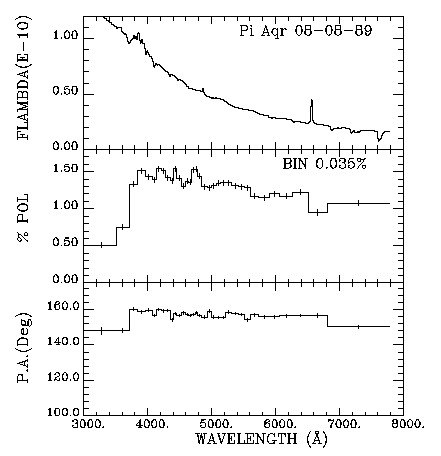|
|||||||||||||||||||
|
|
|||||||||||||||||||
|
|
Data Products
MAST distributes a file of reduced half-wave data provided by the HPOL project that is in FITS format and another of the same data as an ASCII text file.
The information below was taken from the HPOL project website.
HPOL PBO Reticon Halfwave Data Set
These data have been processed by summing equivalent readouts on a particular object, subtraction of background scans, division by the flat field calibration spectra, flux calibration using spectra of known bright stars, and polarimetric calibration using data obtained of unpolarized and polarized standards. For the halfwave mode data, the modulated scans are differenced and a Fourier analysis, pixel-by-pixel as a function of waveplate angle, is done to give Stokes parameters %Q and %U spectra along with a %Error spectrum, all consisting of 1024 32-bit data points for each array from about 3200Å -7700Å with a 25Å resolution.
Data analysis and software development took place at the University of Wisconsin Space Astronomy Laboratory (SAL). Much of the data reduction was accomplished by a FORTRAN language package (REDUCE) generalized for a collection of Reticon detector/spectropolarimeters developed at SAL to support ground-based (HPOL/PBO), the space shuttle-flown Wisconsin Ultraviolet Photo Polarimeter Experiment (WUPPE) and Rocket UV spectropolarimetry. This software package was initially installed on UNIX based microVAXes for several years and is currently on SiliconGraphics machines running IRIX and machines running Linux.
 The figure illustrates the standard data product of the reduction: a three-part spectrum showing the flux, linear polarization, and linear position angle (angle = 0.5*arctan(U/Q)). The polarization is usually "binned" (neighboring pixels averaged until a constant mean error is achieved) to further improve the signal-to-noise. A standard set of spectropolarimetric analysis tools (vector arithmetic, Q-U vector plots, wavelength dependence fitting) are used for scientific interpretation.
The Stokes %Q and %U, and %Error spectra and flux calibrated (Flambda- ergs/cm2/sec/Å) data along with pertinent housekeeping data have been written to a FITS file for each observation.
The figure illustrates the standard data product of the reduction: a three-part spectrum showing the flux, linear polarization, and linear position angle (angle = 0.5*arctan(U/Q)). The polarization is usually "binned" (neighboring pixels averaged until a constant mean error is achieved) to further improve the signal-to-noise. A standard set of spectropolarimetric analysis tools (vector arithmetic, Q-U vector plots, wavelength dependence fitting) are used for scientific interpretation.
The Stokes %Q and %U, and %Error spectra and flux calibrated (Flambda- ergs/cm2/sec/Å) data along with pertinent housekeeping data have been written to a FITS file for each observation.
FITS File Naming Convention
The file name consists of the following:
hpolret_objname_obsdate_hw.fits
where
objname is the name of the object.
The obsdate is the Date (YYYYMMDD) the observation was taken (GMT).
hw is the Halfwave polarimeter mode.
(e.g. hpolret_pi-aqr_19890808_hw.fits)
Description of FITS file
The CFITSIO package, version 2.430 written by Dr. William D. Pence at the Goddard Spaceflight Center, was used to generate the FITS files. They were written on a workstation running Linux. The FITS files are 34560 bytes in length.
An HPOL PBO Reticon Halfwave FITS file looks like the following:
| Primary header |
| Primary data |
| Flux (Flambda) |
| Extension Header |
| Wavel %Q %U %Err |
The set of basic header information includes the primary array keywords and keywords describing the data arrays, target information, telescope engineering data relative to the observation, and calibration information. The exact header of a sample file is given below. The primary array data consists of the Flux array (1024 data points-32 bits per data point) in units of ergs/cm2/sec/Å (Flambda). The binary tables extension includes headers and vectors for wavelength (Angstroms) and the Stokes parameters %Q & %U, and the %Error (also 1024 32-bit data points per array). For the fluxes, bad data have been zeroed out. For the polarization data, the bad data are when the %Error data have been zeroed out. The %Q and %U data remain (allowing inspection of those data) but should not be used.
ASCII listings of HPOL PBO Reticon Halfwave FITS files
ASCII listings of each of the HPOL Reticon Halfwave FITS files have also been provided. Each ASCII file is named
hpolret_objname_obsdate_hw.lis (e.g. hpolret_pi-aqr_19890808_hw.lis)
with the objname and obsdate as defined above.
These files are the output of the program polfitsread.f, which was written to verify the contents of the HPOL PBO Reticon Halfwave FITS files. It also uses the GSFC CFITSIO software package.
|
|
|




 Follow Us
Follow Us